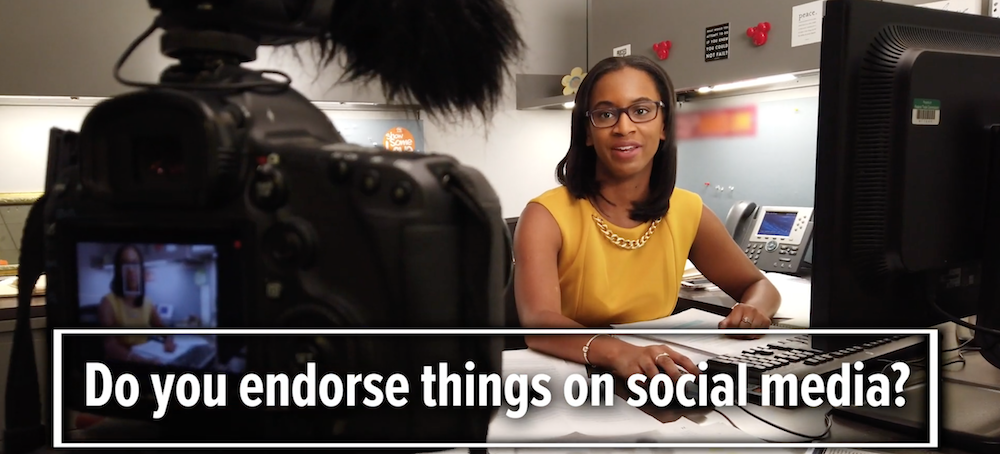
With last Tuesday’s release of a new guide outlining marketing disclosure requirements for online influencers, the Federal Trade Commission appears to be making a statement: We want to blot the gray out of what should be a black-and-white process.
“Disclosures 101 for Social Media Influencers” represents the agency’s most ambitious effort yet to clear up misconceptions around the need to disclose advertising and marketing relationships. Uncharacteristically for a guide produced by a federal agency, it does so using easy-to-parse examples and plainspoken verbiage. It even includes short, generationally attuned videos designed to further demystify the regulations.
“The guidance we gave is intended to make it easier for influencers to comply with the law,” said Michael Ostheimer, a staff attorney in the FTC division of marketing practices. “We believe those connections should be disclosed, whether the influencer is a doctor or a celebrity or anyone else, if they could impact the credibility that followers give to an endorsement.”
While nothing in “Disclosures 101” or the guidance that it underlines specifically addresses health-related marketing, industry marketers hailed the FTC’s efforts to supply additional clarity. “It was definitely needed,” said Missy Voronyak, senior group director, social media and influencer engagement at W2O. “The existing guidance read much more like a legal document.”
Syneos Health managing director, digital Steve Marino agreed, adding, “The important takeaway is that we as an industry have a standard that we have to live up to in an effort to ensure there is a clear indication an endorsement is being given. We owe it to our audience to deliver on transparency in marketing.”
To that end, experts downplayed the guide’s specific applicability to physician and patient influencers. A great majority of the health-adjacent companies that have dabbled in influencer marketing, they noted, make products that are FDA-regulated, while physicians are bound by HIPAA. What that means is most firms who run these programs are already on board with the need for extreme disclosure, in instances where influencers are involved and otherwise.
“We’re accustomed to working within guidelines and disclosure requirements when people publicly speak about or market our clients’ products, whether for pay or not,” explained Pascale Communications head of digital Christian Rodgers. “Unlike FDA’s ISI and PI disclosure requirements for pharma, it looks like the FTC is allowing for creative options, as long as the disclosure is simple, clear and hard to miss.”
Those “creative options” – no “#ad” or “#promotion” is mandated – and the uncommonly familiar tone are what impress influencer-marketing experts most about the new guide. “It was a pleasant surprise, coming from the government,” Marino said. Rodgers noted that “it will be fun to watch if influencers and the brands they represent have fun with the new disclosure rule.”
Voronyak, for her part, singled out the inclusion in the video of a “young, hip woman, who’s an attorney but doesn’t really speak like one” as an especially smart decision. “I think [the FTC] knew they needed to do something different to get the message across. I’m glad they kept the audience in mind,” she said.
Most of the criticisms of the new guide fall into the realm of minor peeve. Despite the FTC’s listing of myriad potential perks that need to be disclosed, there’s some sentiment that it could have mentioned even more – like, say, that a paid-for Uber ride to an event must be disclosed, whether or not the organization picking up the tab has tied the transportation to a post or future coverage.
Experts also expressed some mild surprise about the guide’s affirmation that the burden of disclosure (and the penalties that come with insufficient disclosure) lands squarely on the influencers themselves, rather than the marketers behind a particular endorsement. “As an influencer, it’s your responsibility to make your disclosures compliant, to be familiar with the Endorsement Guides and to comply with laws against deceptive ads,” Rodgers said. “Influencers can’t rely on the marketing entity to do this homework for them, although I’m sure marketers will expect and demand compliance in their influencer agreements.”
So will the new guide serve as the road map influencers and marketers crave? Will the FTC succeed in its efforts to render disclosure a non-issue? Having the information out there in an easy-to-parse format represents a win either way, but nobody is characterizing the guide as a panacea.
“Like with any new guideline, influencers will take notice when they see it being enforced. FTC will most likely want to make examples of a few egregious violators early on to send a signal that they are serious,” Rodgers predicted. “Monitoring and enforcing the billions of influencer impressions present challenges.”
Which is why the FTC reupping the influencer guidance – and, in the process, making clear that it is a living document – might amount to the greatest deterrent of all. “We’ll continue to publicize [the guide] to influencers and we’ll continue to refine it,” Ostheimer says. “And we’ll continue with enforcement when appropriate.”






